Sphinginae subfamily
Sphingini tribe:
 |
Pink-spotted hawkmoth -- (Agrius cingulata) USGS
stray
This moth is a very strong flier, but would only make its way to
Oswego as a rare stray. There are not too many records from New York state.
|
 |
Ceratomia amyntor
WO RL,
the Elm Sphinx or Four-horned Sphinx:
The upperside of the forewing is brown with dark brown and white markings including a white costal area near the wing base,
dark streaks along the veins, and a white spot in the cell. The upperside of the hindwing is light brown and has a dark brown band along the outer margin.
Larvae feed on Elm (Ulmus), birch (Betula), basswood (Tilia), and
cherry (Prunus). |
 |
Ceratomia undulosa
WO RL, the Waved
Sphinx.
The upperside of the forewing is pale brownish gray with wavy black and white lines and a black-outlined white cell spot. The upperside of
the hindwing is gray with diffuse darker bands.
Some individuals are very dark, almost black, and others are light yellowish brown.
|
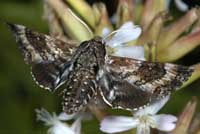 |
The upperside of the forewing is dark brown with a dusting of white scales. Some moths have patches of reddish or yellowish brown on the wings.
|
 |
The upperside of the forewing is gray with heavy black bands. The upperside of the hindwing is brownish gray with no markings.
The underside is rather plain
|
 |
Lintneria eremitus WO, the
Hermit Sphinx. The upperside of the forewing is gray-brown with wavy lines, black dashes, and one or two small white spots near the center of the costa.
The upperside of the hindwing is black with two white bands and a triangular black patch at the base. Note the golden hair on the thorax. |
 |
Manduca quinquemaculatus
WO RL,
the Five-spotted Hawkmoth.
Abdomen usually has five but sometimes six pairs of yellow bands. Fw upperside blurry brown and gray.
Hw upperside banded with brown and white, two well-separated median zigzag bands. Fw fringes are
grayish, not distinctly spotted with white.
|

|
Sphinx canadensis
WO,
Sphinx canadensis, the Canadian Sphinx, is not common, and is not
often reported anywhere.
The absence of the white spot on each forewing and the more brownish coloration serve to separate canadensis from S. poecilus.
The hindwing fringe also tends to be white on poecilus and checkered brownish on canadensis.
|
 |
Sphinx chersis USGS, the Northern Ash Sphinx or Great Ash Sphinx
The upperside of the forewing is soft dark gray to blue-gray with a series of black dashes, one of which reaches the wing tip.
The upperside of the hindwing is black with blurry pale gray bands Larval hosts are ash, lilac, privet, cherry, and quaking aspen.
|
 |
Sphinx drupiferarum
USGS RL, the
Wild Cherry Sphinx.
The forewing is dull slate grey with considerable light grey scaling in a broad band along the costa about 3/4 of distance from body toward the apex.
Median lines are black and thin. There is a wavy,
diffuse dark subterminal line, inwardly bordered by white, and a whitish bar in terminal area, paralleling outer margin.
|
 | The upperside of the forewing ranges from brown with
black borders through brownish gray with paler borders to pale gray
with no borders. Dashes, submarginal line, and cell spot are usually
weak.
|
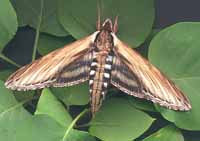 |
Sphinx kalmiae
USGS RL, the Laurel Sphinx.
The lower forewings are predominantly brownish-yellow with a fairly wide dark bar along the inner margin. At rest the wings hug the body,
giving the moth a long slender look.
|
 |
Sphinx luscitiosa WO,
the Canadian Sphinx or
Clemen's Sphinx. The upperside of the forewing is yellowish gray in males and pale gray with a faint yellow tint in females. In both sexes, the dark border on
the outer margin widens as it approaches the inner margin. The upperside of the hindwing is deep yellow in males,
pale yellow in females; both with a wide black border.
|
 |
Sphinx poecila WO, the Poecila Sphinx.
Fringes: Fw: checkered black and white; Hw: almost pure white (lightly checked with grey).
Fw: dark gray with diffuse black and gray wavy lines with series of black dashes ending at wing tip, and white cell spot.
Cell spot readily distinguishes poecila from canadensis. Hw: brownish gray with wide black border and black median line.
|
Smerinthini Tribe:
 |
Amorpha juglandis
USGS RL, the Walnut Sphinx.
The adults are also highly variable; sometimes wings of an individual may be all one color or may have several colors,
ranging from pale to dark brown, and may have a white or pink tinge. Patterns range from faint to pronounced.
|
 |
Pachysphinx modesta
USGS RL,
the Modest Sphinx or Poplar Sphinx
This moth has a large, heavy body, and females can be remarkably plump. Larvae are fond of poplars and willows.
|
 |
Paonias excaecata
WO RL, the Blinded Sphinx.
Fw outer margin is quite wavy. Dark cell spot and dark oblique line mid wing from costa almost to inner margin.
Ground colour is pinkish brown.
At rest the lower wings are almost completely hidden.
Males demonstrate a strong curve to the abdomen.
Gets its name from blue-gray pupil surrounded by black, with hot pink wing scales in hw basal area.
|
 |
Paonias myops
USGS RL, the Small-eyed Sphinx
Named for the small eye-spot in the hindwing, this moth has a wide distribution
and is probably common in Oswego County.
I regularly see them on Prince Edward Island, and they are reported as far south as Florida.
|
 |
This species is now recorded in Oswego, and
is recorded in Tomkins and Tioga. At my home in Montague, P.E.I., Canada, they are quite
common. Larvae feed on poplars and willows.
|
 |
This moth is widely distributed and fairly common.
Along the East Coast, it flies from P.E.I. to Florida.
|
Macroglossinae subfamily
Dilophonotini tribe:
 |
Hemaris diffinis
WO RL, the Snowberry Clearwing or Bumblebee Moth
This moth is widely distributed and has been reported in Oneida and
in Vermont, New Hampshire and Maine.
|
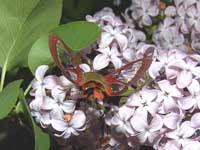 |
Hemaris gracilis BAM, the
Slender Clearwing or Graceful Clearwing
Hemaris gracilis is distinguished from similar species by a pair of red-brown bands on the undersides of the thorax, which varies from green to yellow-green dorsally and sometimes brown with white underneath. They have a red abdomen.
|
 |
Hemaris thysbe
WO RL, the Hummingbird Clearwing
This interesting day flier is now reported in
Oswego, and is widely
reported to the north, east and south.
They are widely distributed in the east from P.E.I. to Florida.
|
Philampelini tribe:
 |
Eumorpha achemon
WO; questionable,
the Achemon Sphinx
This moth is not reported for Oswego, but it is fairly often reported
along the coast from southern New Jersey
to central Maine so may be present, but is generally more southerly.
Note the differences between this moth and the Pandorus Sphinx. |
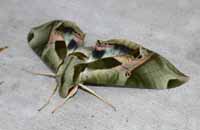 |
If you have Grape or Virginia Creeper nearby, then you probably have
this species.
I often get asked to identify larvae from areas not
previously reported. |
Macroglossini tribe:
 |
This day flier is widely distributed. If you have Virginia Creeper, you
probably have the Nessus Sphinx, and it is now reported from
Oswego.
Two bright, distinct, narrow yellow
bands are often visible on the abdomen.
|
 |
They are common in New Jersey and common
here on Prince Edward Island.
You will often see this species listed as Darapsa pholus,
especially in older literature.
|
 |
Darapsa myron
WO RL, the Virginia Creeper Sphinx or the Grapevine Sphinx
This moth is not recorded on the U.S.G.S. site for Oswego County, but Randy
Lyttle confirms its presence.
It is widely reported as far north as southern Maine. If you have the
foodplants indicated in the common names, you probably have this
species nearby. |
 |
If you have hydrangea growing near a stream, then you may have the
Hydrangea Sphinx.
It has not been widely reported north of Oswego,
however, and probably is uncommon.
|
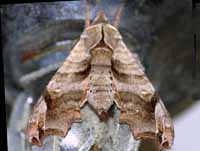 |
This species has been recorded in northeastern New York,
and has been reported to the south so might be present
(now confirmed). It is generally absent to the north so would be uncommon, although
I have reports from Ontario, Canada.
|
 |
Hyles gallii WO, the Bedstraw Hawk Moth
or Gallium Sphinx
This species is not reported in Oswego, but it has been reported in
Onandaga and generally is
a more northerly species.
Some years I see them on P.E.I., some years, I do not.
|
 |
Hyles lineata
WO RL, the White-lined Sphinx
This species is now reported from Oswego County, but it flies across southern New York and
has strong migrating tendancies.
There are records from New Hampshire and Maine.
|
 |
Proserpinus flavofasciata
WO, the Yellow-banded Day Sphinx
Adults fly as a single brood from April-June in meadows in coniferous
forests. Adults fly during the afternoon.
|
 |
This moth is very much under reported across the United States. It
is a rapid day flier so is probably not in too many collections.
Grape is a popular larval host.
|
|
|
